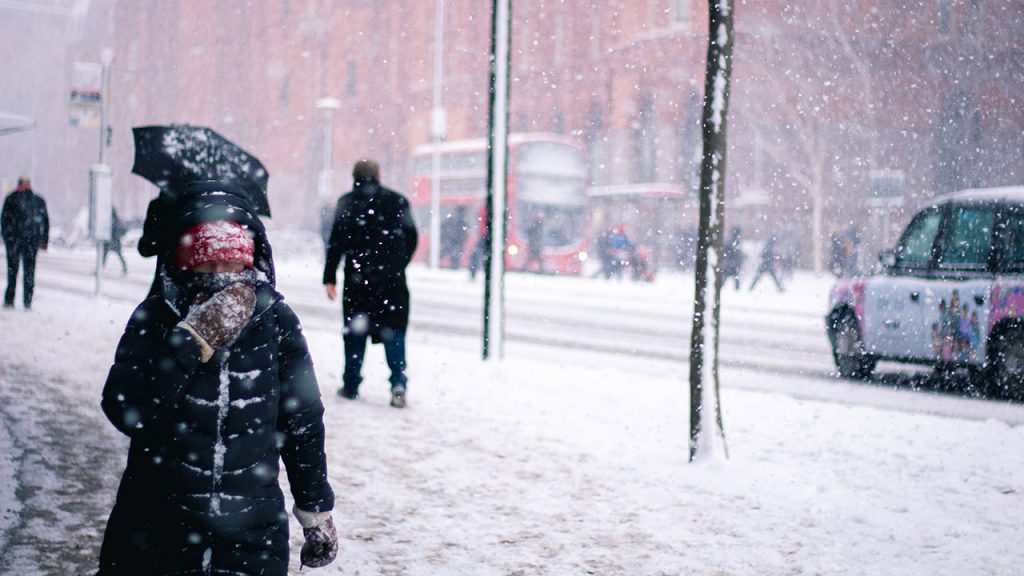
What causes weather?
Weather is made up of six main components. These are temperature, atmospheric pressure, cloud formation, wind, humidity and rain. A small change to any of these conditions can create a different weather pattern.
Every weather pattern has a knock-on effect, creating a ripple effect around the world. That’s why weather can sometimes seem chaotic. It’s constantly changing.
Temperature
Temperature describes how hot or cold the atmosphere is. The atmosphere absorbs heat energy from the sun. But human activities, such as releasing greenhouse gases into the atmosphere, can also affect the earth’s temperature.
Atmospheric pressure
Atmospheric pressure is a result of the weight and density of the air.
Atmospheric pressure changes as air becomes warmer or colder, because the temperature of air affects how dense it is. Warm air molecules have more energy and move further apart, meaning that warm air is less dense than cold air.
Atmospheric pressure also decreases as you move higher into the atmosphere. Imagine the atmosphere as a huge ocean of air that we live underneath. The pressure underneath the weight of the entire ocean is far greater than the pressure near the ocean’s surface. That’s why atmospheric pressure decreases as you move higher in the atmosphere.
High-pressure weather systems tend to bring cooler temperatures and clear skies. On the other hand, low-pressure weather systems bring warm temperatures and more unsettled weather.
Clouds
Clouds are visible masses of water vapour in our atmosphere. They are formed when water evaporates from places like oceans and lakes, and then condenses when it cools down again.
Wind
Wind is the movement of air in the sky. Wind is caused by the different air pressures in our atmosphere. Air from areas of high pressure tries to move into areas of low pressure. The greater the difference between the air pressure, the faster the air moves between the two areas.
Humidity
Humidity describes the amount of water vapour in the air. Water vapour makes up anywhere between 0.1% and 4% of the gases in our atmosphere. Warmer air can carry more water vapour than cooler air, which is why warm tropical climates often feel sticky.
Rain
Rain happens when water droplets fall from clouds in the sky. Clouds are full of tiny water droplets, and as they collect more moisture those droplets become heavier and heavier. Eventually, the droplets become too heavy to stay in the sky, and they fall to the ground.
How does climate change affect weather?
Climate change is making extreme weather more frequent and more severe.
Climate change is being driven by a rapid increase in the temperature of our atmosphere. We know that the average global temperature has increased by around 1°C since the industrial revolution and is getting warmer at increasing pace.
A warmer atmosphere has knock-on effects for many different types of weather, not only warm weather, and will affect different parts of the world differently.
Climate change is making droughts last longer, and heat waves are becoming more frequent. Heavy rainfall and snowfall will become more intense in some places as a warmer atmosphere is able to hold more moisture in the sky. And, high-impact events like storms will become more frequent.
Scientists have studied over three hundred weather events in the last two decades, from wildfires in Alaska to hurricanes in the Carribean, and found that 69% were found to be more likely or more severe by human-caused climate change.
How to forecast the weather?
Weather forecasts attempt to predict the weather conditions in the future. They are short-term predictions, typically between one and seven days in advance.
All weather forecasts begin with observations of the atmosphere. Every day, weather observations are recorded around the world and sent to specialist weather forecasting centres, like the UK Met Office.
Researchers use weather stations that collect information about the state of the atmosphere, including the temperature, atmospheric pressure, wind, humidity, and rain. This information is also combined with satellite images showing cloud movement. Together, this data creates a starting point for predicting how the weather will change.
Scientists input their observations to computer models, which are specially designed to forecast the weather. The computer models create a virtual simulation of the earth’s atmosphere, and have been fine-tuned to predict how the weather will change over time.
These computer models help inform weather forecasters all over the world, from the weather presenter on morning television, to the weather app on your smartphone.
